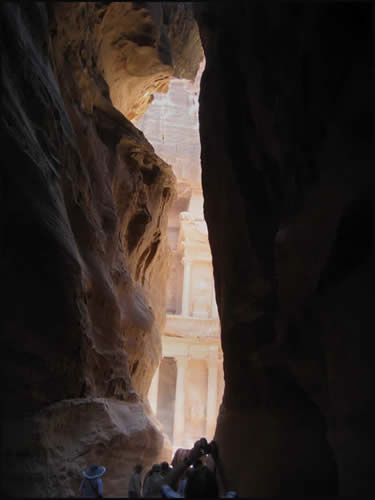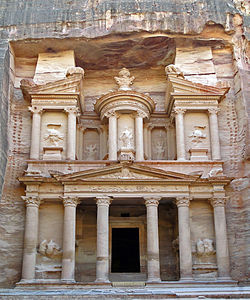
Visitors squeeze through the narrow entrance in front of the “Treasury” of Petra. © 2011, UrbisMedia
We came to Aqaba, Jordan by sea, so the cannons that the Ottoman Turks would have been pointed at us could have blow us out of the water. If it were 1917, of course. That fact made T.E. Lawrence, a.k.a. Lawrence of Arabia, famous. Looking more like Lawrence, Drag Queen of the Desert (at least in David Lean’s movie depiction) he led an Arab force at Aqaba from the undefended land side and won a military victory during WWI that marked the beginning of the end for the Turks in Arabia. That puts Aqaba on this historical map as well as being Jordan’s only seaport.
But we were not long for Aqaba, boarding buses for the long, bleak ride to Jordan’s most famous and popular tourist destination, made even more popular as the discovery location for the Holy Grail inIndiana Jones and the Last Crusade. (Some guy on the bus was actually humming the theme music from the movie.)
I had wanted to see Petra well before Harrison Ford got there. Some years earlier I was gathering information for a documentary script in Beersheva in the Negev Desert and first heard about the Nabataeans, the people who founded/created Petra [See DCJ Archives 19.4: Sweet Waters In The Promised Land (Part 1) 4.10.2005]. The script dealt with desert agriculture and one of the Israeli agronomists told me that the Nabataeans employed a technique whereby they placed a large stone next to plants. During the day the stone would take on heat, but in the cooler night it would create condensation that would drip off the stone and hydrate the plant. A literally cool idea. They were good at water in the desert, as it seems the basic cource of their wealth was that they were able to create a reservoir.
The Nabataeans don’t seem to be around anymore, but their city, literally carved out of rock (hence its name) remains. They were around, however, in the few centuries on either side of the beginning of the C.E., or Christian era. As with all cities Petra (it had other names as well, like Rekem) needed an economic base and it seems that, at that time, the Nabataeans had a good trade in cattle and pitch with the nearby Egyptians, but also, because they had water, served as a caravansary on the trade route between Egypt and Mesopotamia, and later the silk and spice routes to the Orient. They exacted taxes and sold provisions; it was their golden age.
The Nabataeans were also pretty good politically. They maintained good relations with the Romans who, as we know, pretty much ripped off anything they thought was worth a denarius. But by the 3rd C it was pretty much over. Rome had split its empire and was on its way to becoming Christian. Speculation is that it might have been the Persians who took over the Nabataeans and their rock city over.
Sorry, Indiana, I don’t think the Holy Grail (sang real?) ever ended up there (or Petra would have been a stop off in The Da Vinci Code). But you have to be an urbanist like me, or a traveler who has a place like this on their “bucket list,” somebody who doesn’t know they can rent Indiana Jones and the Last Crusade, or a masochist, to want to visit Petra. Why? Not so much because the trek in through what is called the siq (a narrow passage through the wind/water sculpted rock) but because the 2-kilometer downhill schlep over sand-covered rocks, slippery, uneven paving stones and heavy gravel, is a nightmare for anyone who easily sprains ankles and has legs compromised by accidents and more. Like me.*

2011, UrbisMedia
I suppose that inaccessibility contributes to the drama of the approach to the “city.” The narrow gorge of the siq that winds and slopes is evidently formed by an insistent Nature. Only occasionally are there minor human touches. Its length builds the anticipation until the now almost familiar glimpse of the Treasury or Al Khazneh, perhaps the most exquisitely-carved land use among a variety of others spread among the gorges that comb through the broad sandstone mesa, including even an amphitheatre. Many of the cave-like structures are tombs that may have considerably pre-dated Petra becoming a thriving commercial city. But most archeologists contend, despite its contemporary desolate appearance, that it was not “constructed” primarily as a necropolis. In any case, there is likely to be a burial niche available if the brutal climb to see these unique monuments to the human ingenuity in city building happens to kill you.
____________________________________________________________
© 2011, James A. Clapp (UrbisMedia Ltd. Pub. 10.23.2011)
*There are horses one can rent, but my religion forbids riding animals larger than myself. There are small carriages available, too, but the charge for a ride in them does not include a kidney transplant. Anyway, my macho gland kicked in when I saw some little old ladies doing it on foot.
